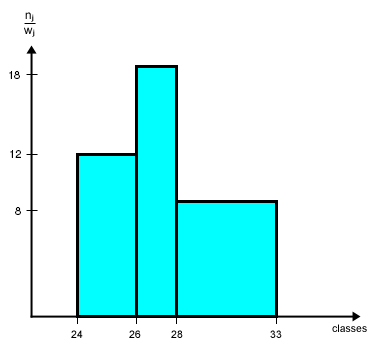Teaching:TUW - UE InfoVis WS 2007/08 - Gruppe 07 - Aufgabe 1 - Histogram: Difference between revisions
Jump to navigation
Jump to search
No edit summary |
No edit summary |
||
| Line 8: | Line 8: | ||
= Example = | = Example = | ||
[[image:histogram_sample.jpg|thumb| | [[image:histogram_sample.jpg|thumb|200px|right|Histogram Illustration]] | ||
<b>Frequency Table (Salary of Employees): </b> | <b>Frequency Table (Salary of Employees): </b> | ||
{| border = 2 class="wikitable" style="text-align:center" | {| border = 2 class="wikitable" style="text-align:center" | ||
!class j | !class j !! absolute frequency n <sub> j!!class interval w <sub> j | ||
|- | |- | ||
| 1 | | 1 (=> 24 ≤ x ≤ 26 )|| 36 || 3 | ||
|- | |- | ||
| 2 | | 2 (=> 26 < x ≤ 28 )|| 37 || 2 | ||
|- | |- | ||
| 3 | | 3 (=> 28 < x ≤ 33 )|| 17 || 5 | ||
|- | |- | ||
| || ||<b>Σ 600</b> || | | || ||<b>Σ 600</b> || | ||
Revision as of 12:11, 2 November 2007
Definitions
In statistics, a histogram is a graphical display of tabulated frequencies. A histogram is the graphical version of a table that shows what proportion of cases fall into each of several or many specified categories. The histogram differs from a bar chart in that it is the area of the bar that denotes the value, not the height, a crucial distinction when the categories are not of uniform width (Lancaster, 1974). The categories are usually specified as non-overlapping intervals of some variable. The categories (bars) must be adjacent.
[Wikipedia, 2007]
A histogram is used when we want to show frequencies of a continous variable. The continous variable can, of course, assume all values within an interval and the histogram reflects this by covering the whole of the interval concerned.
[Wallgreen et al., 1996]
Example

Frequency Table (Salary of Employees):
| class j | absolute frequency n j | class interval w j | |
|---|---|---|---|
| 1 (=> 24 ≤ x ≤ 26 ) | 36 | 3 | |
| 2 (=> 26 < x ≤ 28 ) | 37 | 2 | |
| 3 (=> 28 < x ≤ 33 ) | 17 | 5 | |
| Σ 600 |
Frequency density (height of a column) = n j / w j
Related Links
References
- [Wikipedia, 2007] Wikipedia, Histogram. Retrieved at: November 01, 2007. http://en.wikipedia.org/wiki/Histogram
- [Wallgreen et al., 1996] Anders Wallgreen, Britt Wallgreen, Rolf Persson, Ulf Jorner and Jan-Aage Haaland. Graphing Statistics & Data: Creating Better Charts. SAGE Publications, Thousand Oaks, London, New Delhi, 1996.